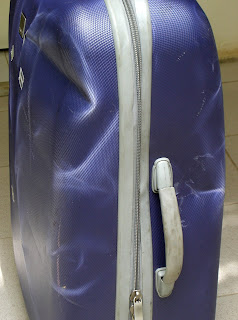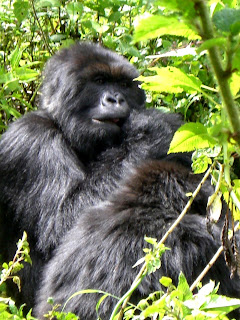
I had forgotten what a lovely country Guinea Bissau is. After the hustle, bustle and hassle of Dakar, Bissau is a haven – like a little backwater village, where you can walk along nearly empty streets and no-one bothers you.
This time I went much further beyond the sleepy capital, and spent a week exploring some of the islands offshore. There are more than 80 islands in the Bijagos archipelago, some inhabited and cultivated, some sacred and left wild, and others designated as national parks. I visited six of them, in a hired boat with three other foreigners plus a captain and his mate.
We started on the island of Quere, a tiny dot too small to figure on the maps. It took around seven minutes to walk from one end to the other! A lovely white beach, blue-cheeked bee-eaters wheeling around catching dragonflies and butterflies, and a comfortable lodge serving delicious freshly caught fish (we saw them being pulled from the sea!) – two nights there was not really enough, but there were more islands to visit.
Next was Orango. This is part of one of two national parks in the archipelago, protected because it is home to the only population of hippos in the world which are adapted to tolerate seawater. We duly organised a trip to see the hippos, unfortunately not in the sea this time but in their more usual haunt, deep in a swamp in the middle of the island. It was a bit of an adventure to get there, wading thigh-deep through the mangrove creeks, walking through head-high grass which released itchy seeds onto your skin, then back into water when we got to the swamp.
Suddenly they were there, snorting noisily in front of us, and the guide told us to climb quickly into the trees as they didn’t like people on their territory. I climbed awkwardly into a tree, to find it home to a number of biting ants, and I peered through the leaves at the occasional hippo head being raised out of the water. Eventually we got down and walked back, one member of our group finding a leech on her ankle as she came out of the water, and all of us with ant bites to go with the mosquito bites we already had.
On the way back to our boat we were taken on a long detour, into another swampy area, where we were told we may see crocodiles. I must say I was quite pleased that we didn’t, given that we were in their water! We did, however, see lots of birds – sacred ibis, herons, spoonbills, geese, etc.
After Orango we journeyed to the furthest island in the entire archipelago, in the other national park, this one primarily designed to protect nesting turtles. Poilao is sacred to the Bijagans; no Bijagan women are allowed there, no permanent construction is allowed, and no visiting men are allowed to shed any blood of any creature. For this reason, perhaps, the turtles come there in their thousands – 30,000 laying their eggs there each year.
We were near the end of the season, but still saw six or seven adult females on the beach, laying their eggs and then dragging themselves across the sand and rocks back to the sea. It looks like such hard work for them, but I suppose it is at least over in a couple of hours, unlike the 24 hours + that so many human females go through!
We also saw some of the young hatching. It can take them 3-4 days to climb through the sand out of the nest, and then they face the dangerous journey across the beach to the sea – a lot safer when tourists are there watching as this keeps the predators away.

In addition to the turtles, we saw another impressive creature on Poilao – a great bittern! This type of bird, normally found hiding in reeds, has never before been recorded in Guinea Bissau according to my bird book, so goodness knows what it was doing there. But due to their habit of freezing, rather than running or flying away, when danger is near, it was very easy to get a close look so there was no doubt as to its identity.
By this stage there were no hotels, so we camped on the sand near the beach, eating tinned sardines and rice that we had brought with us, and washing in seawater.
This was followed by another night under canvas (this time with freshly caught fish for dinner!), at the neighbouring island of Meio.

Meio is also in the national park, and so is also uninhabited – and was the most beautiful of all the places we visited. I wanted to stay another night (or maybe another week). But the decision was made to move on – so far each island had been more beautiful than the last – and we made our way to Canhabaque.
This was indeed beautiful, with a white sandy beach that seemed to go on for ever, but unfortunately we could not find anywhere suitable to camp, so we moved on to Bubaque. Here there was a great site for camping, but at low tide the beach became an endless series of mudflats, and a number of sting rays lurking in the shallows put me off my swim even when I made it across the mud to the water. It was still lovely to sleep out for another night though, and I was sad to be going back to civilisation the next day (a day earlier than planned as the legislative elections due on our last day were for some reason accompanied by a travel curfew).
So we waved goodbye to our boat and its crew, shook the sand from our tents, and climbed aboard the public ferry back to the mainland. We realised how chilled out we had become in our week away when the boat got stuck on a sandbank half-an-hour outside Bissau. We didn’t worry, we didn’t complain, we just ordered another glass of wine from the bar and danced to the drums being played by some of the other passengers for the four hours it took for the water to rise and float us free.







































